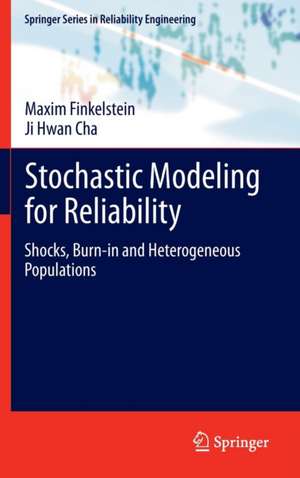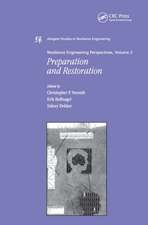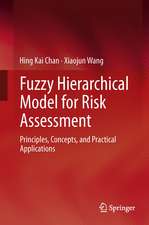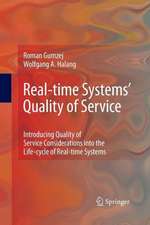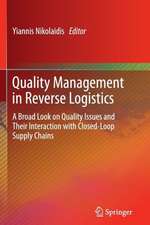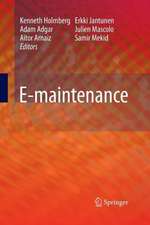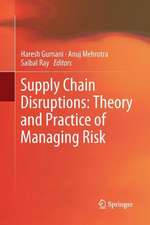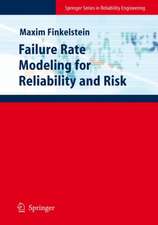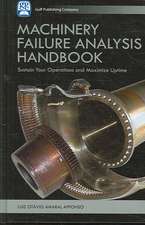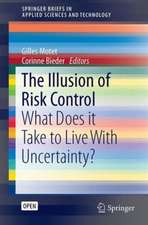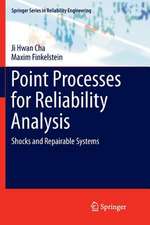Stochastic Modeling for Reliability: Shocks, Burn-in and Heterogeneous populations: Springer Series in Reliability Engineering
Autor Maxim Finkelstein, Ji Hwan Chaen Limba Engleză Hardback – 24 apr 2013
The populations of manufactured items in industry are usually heterogeneous. However, the conventional reliability analysis is performed under the implicit assumption of homogeneity, which can result in distortion of the corresponding reliability indices and various misconceptions. Stochastic Modeling for Reliability fills this gap and presents the basics and further developments of reliability theory for heterogeneous populations. Specifically, the authors consider burn-in as a method of elimination of ‘weak’ items from heterogeneous populations. The real life objects are operating in a changing environment. One of the ways to model an impact of this environment is via the external shocks occurring in accordance with some stochastic point processes. The basic theory for Poisson shock processes is developed and also shocks as a method of burn-in and of the environmental stress screening for manufactured items areconsidered.
Stochastic Modeling for Reliability introduces and explores the concept of burn-in in heterogeneous populations and its recent development, providing a sound reference for reliability engineers, applied mathematicians, product managers and manufacturers alike.
| Toate formatele și edițiile | Preț | Express |
|---|---|---|
| Paperback (1) | 949.55 lei 6-8 săpt. | |
| SPRINGER LONDON – 22 mai 2015 | 949.55 lei 6-8 săpt. | |
| Hardback (1) | 955.70 lei 6-8 săpt. | |
| SPRINGER LONDON – 24 apr 2013 | 955.70 lei 6-8 săpt. |
Din seria Springer Series in Reliability Engineering
- 18%
 Preț: 1406.66 lei
Preț: 1406.66 lei - 18%
 Preț: 1122.56 lei
Preț: 1122.56 lei - 20%
 Preț: 1277.89 lei
Preț: 1277.89 lei - 18%
 Preț: 952.09 lei
Preț: 952.09 lei - 24%
 Preț: 1048.70 lei
Preț: 1048.70 lei - 20%
 Preț: 940.34 lei
Preț: 940.34 lei - 20%
 Preț: 987.32 lei
Preț: 987.32 lei - 18%
 Preț: 951.29 lei
Preț: 951.29 lei - 18%
 Preț: 947.02 lei
Preț: 947.02 lei - 15%
 Preț: 651.51 lei
Preț: 651.51 lei - 15%
 Preț: 635.65 lei
Preț: 635.65 lei - 18%
 Preț: 1228.44 lei
Preț: 1228.44 lei - 18%
 Preț: 1227.67 lei
Preț: 1227.67 lei - 18%
 Preț: 952.89 lei
Preț: 952.89 lei - 18%
 Preț: 1234.94 lei
Preț: 1234.94 lei - 18%
 Preț: 952.09 lei
Preț: 952.09 lei - 18%
 Preț: 1236.19 lei
Preț: 1236.19 lei - 18%
 Preț: 1322.35 lei
Preț: 1322.35 lei - 20%
 Preț: 1274.57 lei
Preț: 1274.57 lei - 15%
 Preț: 643.34 lei
Preț: 643.34 lei - 18%
 Preț: 1109.16 lei
Preț: 1109.16 lei - 15%
 Preț: 635.65 lei
Preț: 635.65 lei - 15%
 Preț: 654.62 lei
Preț: 654.62 lei - 18%
 Preț: 944.99 lei
Preț: 944.99 lei - 18%
 Preț: 953.65 lei
Preț: 953.65 lei - 18%
 Preț: 1213.16 lei
Preț: 1213.16 lei - 18%
 Preț: 956.50 lei
Preț: 956.50 lei - 15%
 Preț: 644.95 lei
Preț: 644.95 lei - 18%
 Preț: 950.52 lei
Preț: 950.52 lei - 18%
 Preț: 1233.97 lei
Preț: 1233.97 lei - 15%
 Preț: 640.06 lei
Preț: 640.06 lei - 18%
 Preț: 956.69 lei
Preț: 956.69 lei - 18%
 Preț: 940.39 lei
Preț: 940.39 lei - 18%
 Preț: 948.92 lei
Preț: 948.92 lei -
 Preț: 389.70 lei
Preț: 389.70 lei - 18%
 Preț: 943.73 lei
Preț: 943.73 lei - 18%
 Preț: 940.57 lei
Preț: 940.57 lei - 20%
 Preț: 985.03 lei
Preț: 985.03 lei - 18%
 Preț: 943.43 lei
Preț: 943.43 lei - 18%
 Preț: 1218.21 lei
Preț: 1218.21 lei - 18%
 Preț: 948.16 lei
Preț: 948.16 lei - 18%
 Preț: 948.92 lei
Preț: 948.92 lei - 18%
 Preț: 1727.24 lei
Preț: 1727.24 lei - 15%
 Preț: 638.43 lei
Preț: 638.43 lei - 24%
 Preț: 802.76 lei
Preț: 802.76 lei
Preț: 955.70 lei
Preț vechi: 1165.49 lei
-18% Nou
Puncte Express: 1434
Preț estimativ în valută:
182.89€ • 198.60$ • 153.63£
182.89€ • 198.60$ • 153.63£
Carte tipărită la comandă
Livrare economică 22 aprilie-06 mai
Preluare comenzi: 021 569.72.76
Specificații
ISBN-13: 9781447150275
ISBN-10: 1447150279
Pagini: 368
Ilustrații: XIV, 388 p.
Dimensiuni: 155 x 235 x 28 mm
Greutate: 0.74 kg
Ediția:2013
Editura: SPRINGER LONDON
Colecția Springer
Seria Springer Series in Reliability Engineering
Locul publicării:London, United Kingdom
ISBN-10: 1447150279
Pagini: 368
Ilustrații: XIV, 388 p.
Dimensiuni: 155 x 235 x 28 mm
Greutate: 0.74 kg
Ediția:2013
Editura: SPRINGER LONDON
Colecția Springer
Seria Springer Series in Reliability Engineering
Locul publicării:London, United Kingdom
Public țintă
ResearchCuprins
1.Introduction.- 2.Basic Stochastics for Reliability Analysis.- 3.Shocks and Degradation.- 4.Advanced Theory for Poisson Shock Models.- 5.Heterogeneous Populations.- 6.The basics of Burn-in.- 7.Burn-in for Repairable Systems.- 8.Burn-in for Heterogeneous Populations.- 9.Shocks as Burn-in.- 10.Stochastic Models for Environmental Stress Screening.
Recenzii
From the reviews:
“This book is a major work for studying and learning reliability theory. … The book is aimed at graduate students or researchers in reliability or applied probability, engineering, mathematics, and statistics. … this book is an extremely valuable contribution to the literature on reliability. It is very well written, and will have a major impact on future research in reliability. It is up-to-date and gives the reader excellent insight into important areas.” (Myron Hlynka, Mathematical Reviews, January, 2014)
“In the framework of stochastic modeling for reliability a combination of the three areas shock models, burn-in and stochastic modeling in heterogeneous populations is presented. … The book can be recommended for reliability engineers, statisticians working in reliability engineering, as well as for courses in advanced methods for reliability models and methods.” (Kurt Marti, zbMATH, Vol. 1271, 2013)
“This book is a major work for studying and learning reliability theory. … The book is aimed at graduate students or researchers in reliability or applied probability, engineering, mathematics, and statistics. … this book is an extremely valuable contribution to the literature on reliability. It is very well written, and will have a major impact on future research in reliability. It is up-to-date and gives the reader excellent insight into important areas.” (Myron Hlynka, Mathematical Reviews, January, 2014)
“In the framework of stochastic modeling for reliability a combination of the three areas shock models, burn-in and stochastic modeling in heterogeneous populations is presented. … The book can be recommended for reliability engineers, statisticians working in reliability engineering, as well as for courses in advanced methods for reliability models and methods.” (Kurt Marti, zbMATH, Vol. 1271, 2013)
Notă biografică
Dr. Maxim Finkelstein received his M.Sc degree in Mathematical Physics from Leningrad State University (1971), Ph.D in OR from Leningrad Elektropribor Institute, 1979 and Doctor of Science degree (habilitation) in OR from St.-Petersburg Elektropribor Institute (1993).
Currently he is a Senior Professor at the Department of Mathematical Statistics, University of the Free State, Republic of South Africa and a visiting researcher at the Max Planck Institute for Demographic Research, Rostock, Germany.
His main research interests are: reliability theory and applications, survival analysis, risk and safety modelling, applied stochastic processes. He had published more than 160 papers and 5 books on different aspects of reliability and stochastic modelling. His last book "Failure rate modelling for reliability and risk" was published by Springer in 2008. He is the Editor of “South African Statistical Journal” and serves as a board member and Associate Editor for a number of international journals.
Dr. Ji Hwan Cha received his B.Sc degree in Computer Science and Statistics from Seoul National University, Korea, in 1993 and his M.Sc and Ph.D degrees in Statistics from Seoul National University in 1995 and 1999, respectively.
He is an Associate Professor at the Department of Statistics, Ewha Womans University, Seoul, Korea. He is an associate editor of Journal of the Korean Statistical Society. He has published numerous papers in various international journals and two books on Introductory Statistics and Reliability Theory, respectively (in Korean). His research interests include applied probability, reliability theory, stochastic processes, stochastic operations research and management science.
Currently he is a Senior Professor at the Department of Mathematical Statistics, University of the Free State, Republic of South Africa and a visiting researcher at the Max Planck Institute for Demographic Research, Rostock, Germany.
His main research interests are: reliability theory and applications, survival analysis, risk and safety modelling, applied stochastic processes. He had published more than 160 papers and 5 books on different aspects of reliability and stochastic modelling. His last book "Failure rate modelling for reliability and risk" was published by Springer in 2008. He is the Editor of “South African Statistical Journal” and serves as a board member and Associate Editor for a number of international journals.
Dr. Ji Hwan Cha received his B.Sc degree in Computer Science and Statistics from Seoul National University, Korea, in 1993 and his M.Sc and Ph.D degrees in Statistics from Seoul National University in 1995 and 1999, respectively.
He is an Associate Professor at the Department of Statistics, Ewha Womans University, Seoul, Korea. He is an associate editor of Journal of the Korean Statistical Society. He has published numerous papers in various international journals and two books on Introductory Statistics and Reliability Theory, respectively (in Korean). His research interests include applied probability, reliability theory, stochastic processes, stochastic operations research and management science.
Textul de pe ultima copertă
Focusing on shocks modeling, burn-in and heterogeneous populations, Stochastic Modeling for Reliability naturally combines these three topics in the unified stochastic framework and presents numerous practical examples that illustrate recent theoretical findings of the authors.
The populations of manufactured items in industry are usually heterogeneous. However, the conventional reliability analysis is performed under the implicit assumption of homogeneity, which can result in distortion of the corresponding reliability indices and various misconceptions. Stochastic Modeling for Reliability fills this gap and presents the basics and further developments of reliability theory for heterogeneous populations. Specifically, the authors consider burn-in as a method of elimination of ‘weak’ items from heterogeneous populations. The real life objects are operating in a changing environment. One of the ways to model an impact of this environment is via the external shocks occurring in accordance with some stochastic point processes. The basic theory for Poisson shock processes is developed and also shocks as a method of burn-in and of the environmental stress screening for manufactured items areconsidered.
Stochastic Modeling for Reliability introduces and explores the concept of burn-in in heterogeneous populations and its recent development, providing a sound reference for reliability engineers, applied mathematicians, product managers and manufacturers alike.
The populations of manufactured items in industry are usually heterogeneous. However, the conventional reliability analysis is performed under the implicit assumption of homogeneity, which can result in distortion of the corresponding reliability indices and various misconceptions. Stochastic Modeling for Reliability fills this gap and presents the basics and further developments of reliability theory for heterogeneous populations. Specifically, the authors consider burn-in as a method of elimination of ‘weak’ items from heterogeneous populations. The real life objects are operating in a changing environment. One of the ways to model an impact of this environment is via the external shocks occurring in accordance with some stochastic point processes. The basic theory for Poisson shock processes is developed and also shocks as a method of burn-in and of the environmental stress screening for manufactured items areconsidered.
Stochastic Modeling for Reliability introduces and explores the concept of burn-in in heterogeneous populations and its recent development, providing a sound reference for reliability engineers, applied mathematicians, product managers and manufacturers alike.
Caracteristici
Provides methods for decreasing the cost of burn-in Can be used as a basis for a postgraduate course on reliability engineering Describes new settings and approaches that can be useful to researchers
